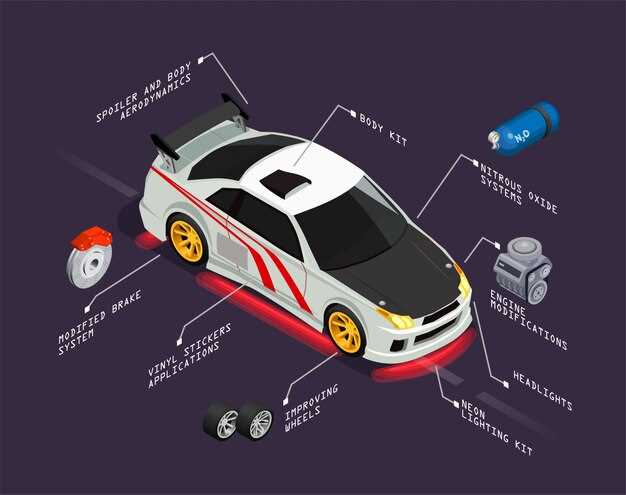
In the high-octane world of motorsport, the construction of race cars has evolved significantly, driven by the need for enhanced performance and safety. The choice of materials plays a crucial role in the overall build quality of these vehicles, directly impacting their speed, efficiency, and handling. Among the various materials utilized, fiber composites have emerged as a game-changer, providing unparalleled strength-to-weight ratios that are essential for competitive racing.
Fiber-reinforced polymers, including carbon fiber and fiberglass, are at the forefront of modern race car construction. These advanced materials allow engineers to design lighter and more aerodynamic vehicles without compromising structural integrity. The integration of fiber composites not only boosts race performance by reducing weight, but also enhances fuel efficiency and responsiveness on the track. This fusion of innovation and engineering expertise represents a significant leap towards the future of racing technology.
As manufacturers continue to refine their techniques and explore new materials, the implications for race car design are profound. Each innovation in fiber technology opens new avenues for build quality and race performance, ensuring that teams remain competitive in the ever-evolving landscape of motorsport. Understanding these key materials is essential for anyone looking to grasp the intricacies of modern race car construction.
Advantages of Carbon Fiber in Lightweight Race Car Design

Carbon fiber is a revolutionary material in the construction of lightweight race cars, offering several distinct advantages that enhance performance on the track. One of the primary benefits is its exceptional strength-to-weight ratio, which allows engineers to create robust structures without adding unnecessary mass. This characteristic is crucial in racing, where every gram counts towards achieving faster lap times.
Moreover, carbon fiber provides increased rigidity compared to traditional materials like steel or aluminum. This rigidity improves the overall handling and responsiveness of the vehicle, enabling better cornering and stability at high speeds. When used in chassis and body components, carbon fiber helps maintain the car’s aerodynamic profile, reducing drag and ultimately enhancing speed.
Additionally, carbon fiber’s resistance to fatigue and corrosion ensures that race cars maintain their structural integrity over time. This durability translates into lower maintenance costs and longer lifespans for critical components, making it a cost-effective choice in the long run despite its higher initial cost compared to metals.
Another significant advantage is the versatility of carbon fiber in design applications. Manufacturers can mold it into complex shapes, allowing for innovative aerodynamic features that improve airflow and cooling efficiency. This adaptability enables designers to push the boundaries of race car design, optimizing both aesthetics and performance.
In conclusion, the incorporation of carbon fiber in lightweight race car design fundamentally transforms the approach to speed, agility, and efficiency. As the racing industry continues to evolve, carbon fiber remains at the forefront, driving advancements that enhance the competitive edge on the track.
Comparative Analysis of Carbon Fiber and Aluminum in Racing Applications

In the world of racing, the choice of materials plays a critical role in performance, safety, and overall vehicle dynamics. Carbon fiber and aluminum are two of the most commonly used materials in constructing race cars, each offering distinct advantages and disadvantages. Understanding these differences is essential for engineers and designers aiming to optimize race car build quality.
Carbon fiber is renowned for its high strength-to-weight ratio. It is significantly lighter than aluminum, allowing race cars to achieve higher speeds and better fuel efficiency. The structural rigidity of carbon fiber also enhances vehicle handling and responsiveness. However, the cost of carbon fiber is considerably higher than aluminum, impacting budget constraints, especially for amateur racing teams.
On the other hand, aluminum is easily accessible and cost-effective, making it a popular choice for many racing applications. It provides a good balance between weight and strength but falls short compared to the performance characteristics of carbon fiber. While aluminum components can be reinforced, they tend to be heavier, which may adversely affect acceleration and cornering capabilities.
Another crucial aspect relates to the durability of materials under extreme racing conditions. Carbon fiber exhibits excellent resistance to fatigue and can withstand high-stress distributions better than aluminum, which may suffer from fatigue failures over time. This longevity can be advantageous in endurance races where vehicles encounter varied and challenging conditions.
However, in the event of an accident, carbon fiber can shatter upon impact, whereas aluminum tends to bend or deform, potentially providing more protection to the driver. Therefore, safety considerations also play a significant role in material selection, influencing the decision between carbon fiber and aluminum based on the specific requirements of the racing environment.
In summary, both carbon fiber and aluminum have their respective merits and drawbacks in racing applications. Carbon fiber excels in terms of weight reduction, strength, and durability, making it ideal for high-performance vehicles. Conversely, aluminum offers a budget-friendly alternative with reasonable strength, but it may not meet the highest performance standards required in competitive racing. The choice ultimately depends on the goals, budget, and strategic priorities of the racing team.
Durability and Maintenance Considerations for Carbon Fiber Components
Carbon fiber has revolutionized race car construction, offering exceptional strength-to-weight ratios. However, its unique properties demand specific attention regarding durability and maintenance.
Understanding the characteristics of carbon fiber is crucial for ensuring longevity and performance:
- Impact Resistance: While carbon fiber is strong, it is also susceptible to damage from impacts. Even minor dings can compromise the integrity of the component.
- Fatigue: Repeated stress can lead to fatigue, causing microcracks to develop over time. Regular inspections are necessary to identify potential failures early.
- Environmental Factors: Exposure to UV light, moisture, and chemicals can degrade carbon fiber. Protective coatings are recommended to shield against these elements.
Maintenance of carbon fiber components includes specific practices to extend their lifespan:
- Regular Inspections: Conduct frequent visual inspections for cracks, delaminations, or discoloration.
- Cleaning: Use gentle cleaning agents and soft cloths to avoid scratching the surface. Harsh chemicals may damage the resin matrix.
- Repairs: In case of minor damage, repairs should be handled by professionals trained in carbon fiber techniques to ensure safety and performance.
When building components from carbon fiber, incorporating elements such as strategic layering and reinforcements can enhance durability. Understanding the manufacturing techniques and the proper use of resins is essential in producing reliable parts.
In conclusion, while carbon fiber offers numerous benefits for race car construction, careful attention to durability and maintenance is critical. Implementing a proactive maintenance schedule can significantly mitigate potential risks, ensuring the performance and safety of carbon fiber components on the track.



